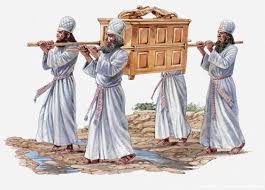The Kohathites
First Chronicles 23: 12-20
David started making the arrangements for Temple services
several years before the end of his life.

Kohath was the second of Levi’s three sons and ancestor of Moshe and Aaron (Genesis 46:11; Exodus 6:16-20; Numbers 3:17; First Chronicles 6:1). Few personal details are recorded about him. Being invariably listed between his brothers Gershon and Merari, he lived for 133 years and had four sons. The information about his descendants is more detailed, since the Kohathites were among the most important Levitical clans. The Gershonites, Kohathites and Merarites each had specific roles within the Levitical culture. The Kohathites were charged with carrying the most holy furniture associated with the Tabernacle (see the commentary on Numbers, to see link click At – The Clan of Kohath). They carried the holy things, the ark of the Covenant, the mercy seat, the lampstand, the altars, the table for the bread of the Presence, and all the other sacred utensils of the Sanctuary (Numbers 4:4-14, 10:21; First Chronicles 9:32). The Sanctuary objects that the Kohathites transported were to be carried on their shoulders with poles made for that purpose (Numbers 7:9; Exodus 25:26–28).
In the Chronicler’s account of the period of the monarchy, the Kohathites are mentioned in connection with four kings: David, Hezekiah, Jehoshaphat, and Josiah, always in relation to service in the Tabernacle or Temple. According to Chronicles, it was during David’s reign, that the family of Heman the Kohathite was among the Levites assigned to direct the singing in the Tabernacle (First Chronicles 6:16-23; Psalm 88:1). Led by Uriel, the leader, 120 Kohathites participated in the installation of the Ark in Jerusalem (First Chronicles 15:5), and the family is again listed in their courses (First Chronicles 23:1-6, 12). Another tradition in Chronicles reports that in the days of King Jehoshaphat, during the invasion of Judah by the Moabites and Ammonites, it was the Kohathites who led the congregation in praise of God at the service of intercession (Second Chronicles 20:19), and two of their men supervised the work of renovation of the Temple undertaken by King Josiah (Second Chronicles 34:12). In the era of the return to Yerushalayim, the time of Ezra and Nehemiah, when functions were being decided for ministry in the Temple, several of the sons of Kohath were put in charge of the changing of the bread of the Presence (First Chronicles 9:32). The only negative episode in the Bible relating to the Kohathites was the rebellion of Korah, grandson of Kohath, against the leadership of Moses and Aaron (see the commentary on Jude Aq – They Have Taken the Way of Cain, Rushed into Balaam’s Error, and have been Destroyed by Korah’s Rebellion).
As Levites, Gershonites, Kohathites, and Merarites did not receive a specific territory in the Promised Land. Rather, they were given cities and pasturelands from among the territories of the other tribes by the command of ADONAI. The Kohathites received thirteen cities from the tribes of Judah, Benjamin, and Simeon and ten cities from Ephraim, Manasseh, and Dan. The distribution of the cities was decided by the drawing of lots (Joshua 21:1–8), and six of the Levites’ cities were designated as cities of refuge.
The descendants of Kohath were Amram, Izhar, Hebron and Uzziel – four in all. So the Kohathites consisted of four families, the Amramites, the Izharites, the Hebronites, and the Uzzielites. Their place in the wilderness was on the southern side of the Tabernacle (see the commentary on Exodus Ep – The Camp of the Twelve Tribes of Isra’el). One of Kohath’s descendants, Amram, fathered Aaron and Moshe (First Chronicles 23:12-13). The role of these verses is to make clear the differentiation, within the tribe of Levi, between the lines of Aaron’s two sons. Aaron, of course, was set apart, he and his descendants forever, to consecrate the most holy things, to offer sacrifices before the LORD, to minister before Him and to pronounce blessings in His name forever. But the descendants of Moses were limited to lesser Levitical duties even though they were counted as part of the tribe of Levi. Through Moshe’s two sons, Gershom and Eliezer, there arose descendants who were leaders such as Shubael and Rehabiah.
Although it is not explicitly stated, the whole tribe of Levi is considered as holy, while the priests are considered most holy. This is a unique phrase. For although the Most Holy Place is descriptive of several holy instruments, the ark of the Covenant (see the commentary on Exodus Fs – The Mercy Seat in the Most Holy Place: Christ at the Throne of Grace), and the mercy seat (see the commentary on Exodus Fr – The Ark of the Covenant in the Most Holy Place: Christ at the Throne of Grace), it is never applied to humans. In Exodus, YHVH instructed Moshe to prepare a sacred anointing oil with which to anoint the Tabernacle and all its vessels on the one hand, and Aaron and his sons, on the other (see the commentary on Exodus Gf – Dedicate Aaron and His Sons So They May Serve Me as Priests). Therefore, just as the Tabernacle and its sacred utensils became most holy through the anointing of oil, so also Aaron and his descendants are most holy.519
A second descendant of Kohath, Izhar, was the source of the line that produced the leader Shelomith.
A third descendant of Kohath, Hebron, was the father of four Levitical leaders: Jeriah, Amariah, Jahaziel, and Jekameam.
Kohath’s last descendant, Uzziel, fathered the line of Micah and Isaiah. Thus, with the descendants of Kohath, ten more divisions are derived for a total of nineteen.



Leave A Comment